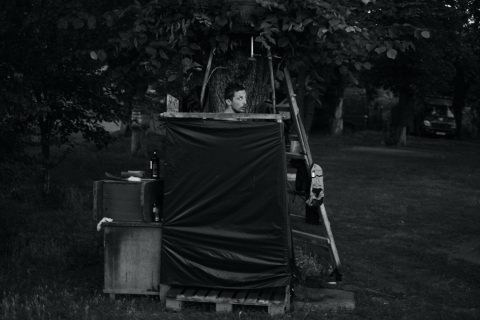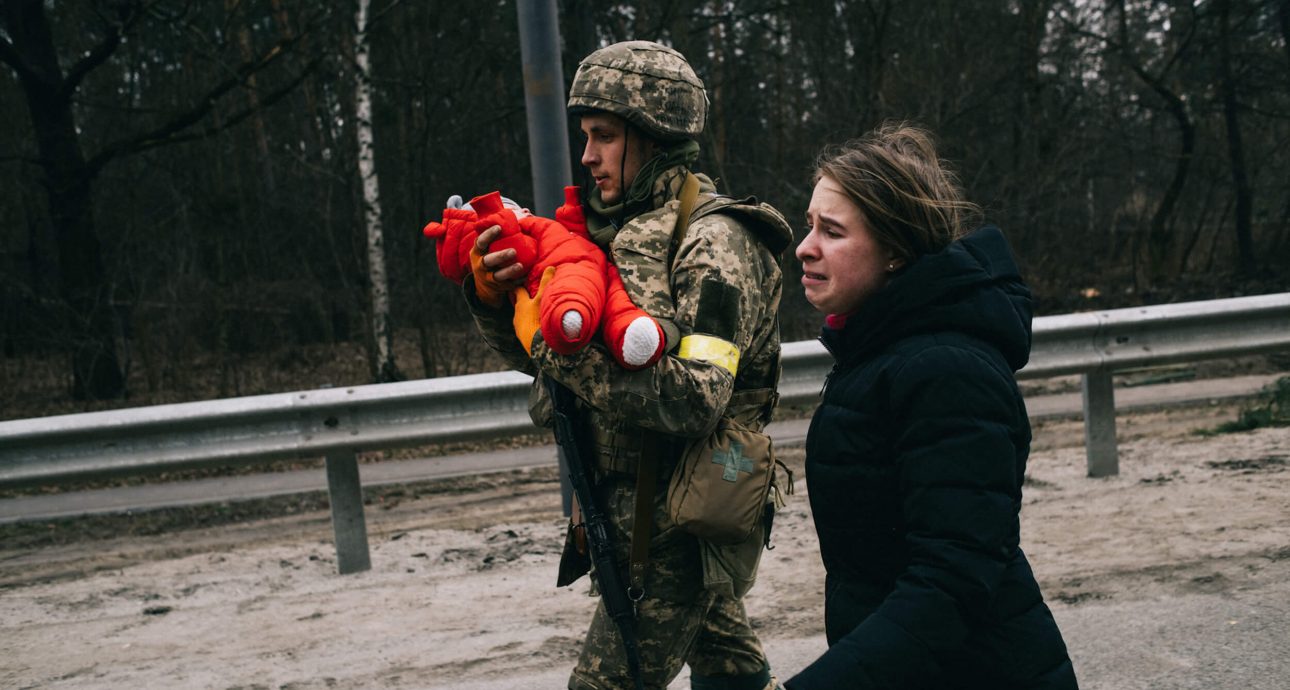
Maksym Dondyuk: “We Manipulate People, Each of Us in Our Own Way”
You’ve been to the Kherson region recently. Can you describe the atmosphere there?
I’ve been there only for a day, with the military and the President. I saw many people gathering on the main square and chanting “Ukrainian Armed Forces! Zelensky!”. People were happy but they also realized that shelling would follow closely.
You have reported on the war since 2014, but you call yourself a documentary photographer in all of your interviews. Why not a war photographer?
To be honest, I rarely call myself a documentary photographer either. There is this concept in Western countries, called documentary art. It’s when a photographer doesn’t interfere in reality but still works as a visual artist. So, I’m a visual artist who works with documentary photography, copy, and video. But I started as a photojournalist. The documentary is so deeply rooted in my DNA that I can’t just walk away from it. I think my main task, as a documentary photographer, is to capture history.
Now, when Ukraine is at war, I believe that I can do more good for my country and for history, by holding a camera, rather than a shotgun. But I don’t have the slightest intention to go and document wars elsewhere, in other countries. I’m not a war photographer. I just report on the war, because it happens to be a part of Ukraine’s history.
I’m not a war photographer. I just report on the war, because it happens to be a part of Ukraine’s history.

The Kiev maternity unit was forced to move completely to the basement of their hospital, after the destruction of the house next to them. Kyiv, 2 March, 2022

Debris of a burned helicopter in Mala Rohan' village near Kharkiv, Ukraine, 15 May 2022

Kharkiv hospital, Valery 27 years old, was at home during a rocket shelling, as a result his two legs were amputated. Kharkiv, 26.03.2022.

A bridge was blown up near the previous front line where there were fierce fights in the Kharkiv region.

Blown up bridge over the river in the city of Izyum.
Let’s go back to 2014 when you were working on the other side of the frontline. Could you tell me about that experience? How were you treated there?
Back in the day, when I was documenting the Revolution of Dignity, I had a rule — always listen to both sides. Whenever I had an opportunity I tried to spend some time with the police, although my sympathies were completely on the protesters’ side. But as a documentary photographer, I wanted to show what was going on “there” because things are never black and white. Everyone has their truth.
In 2014, I went to the other side of the frontline. It was easy to do back then. Everything was so blurry and surrealistic, photographers and journalists had no problems crossing the frontline. I’ve been to Donetsk and to Sloviansk with the Strelok group (a group of separatists led by Igor Girkin — editor’s note), which was taking over a police station in Kramatorsk. I was working “undercover”. My photos were published in the Russian media called “Russkiy reporter”, I had their ID. No one would have suspected me of being a fake, even though I had a Ukrainian passport.
Did you have to use your cover?
Well, actually this whole story ended up with me having a bag over my head and being shot with blank cartridges. I really got what was coming for me. And I got that, in particular, thanks to our media. I posted my photos on Instagram, and our media — “24 Channel” and “Ukrainskaya pravda” — used them without my permission. More to that, they called me their special reporter, who was allegedly documenting the events in occupied territories. It was a disaster for me. I had a couple of friends from Moscow and they tried to cover up for me. They said I was “one of them”. And the Ukrainian media didn’t care. When I asked them for an explanation, they simply said that I shouldn’t have posted the photos online. I haven’t worked with Ukrainian publications since that time. I don’t post images on Instagram either — my wife does that.
How did you get out of that blank cartridge shooting?
I just kept lying. I had a fake ID from a Russian publication, and Russian photographers vouched for me. I was arrested together with Simon Ostrovsky, and they really hated him. They put bags over our heads, lined us in front of the wall, and fired several shots somewhere. Then we were taken to Sloviansk for interrogation. I recognized Strelkov’s voice. And then they let us go — everyone but Ostrovsky. Maybe, I was arrested because of him; maybe because of my photos in Ukrainian media; or maybe because the whole situation got too intense. I just feel uneasy about the fact that people who work for Russian propaganda helped me more than Ukrainian media.
We were taken to Sloviansk for interrogation. I recognized Strelkov’s voice.
Speaking of Russian propaganda, have you noticed Russian photographers staging photos for propaganda? Have you been in situations when you were allowed to document this and not allowed to document that?
You see, the way photos are used after they are taken is something that is usually out of photographers’ control. For instance, there was a photo from Bosnia and Herzegovina, showing children who were killed under shelling. And both sides published the very same photo, only with different captions.
I saw Ukrainian troops entering Sloviansk, it was so chaotic, everyone was under heavy fire. As a result, a woman died. I took a picture of her, but when I showed it at an exhibition in Lviv I was called a pro-Russian bastard. But this is war, anything can happen here.
We are now living inside two propagandas — they have theirs, and we have ours. The truth is probably somewhere in between. But I am a part of Ukrainian propaganda, I chose my side. And they are a part of Russian propaganda, standing on their side. And I don’t know what I would do if I were them. I know that some Russian photographers have left the country. I’m not sure that they did the right thing. There are others, those who decided to stay and basically work for propaganda, but they document history in a way.
Think of
A photographer, war correspondent, born in Donetsk, member of the USSR Photographers Union

A volunteer search group from Odesa “Memory and Glory”, which cooperates with a military search team "On the shield”, is collecting the bodies of Russian soldiers who were ambushed and killed on the Kharkiv-Izium highway. 2 October, 2022

One of the squares of Izyum with abandoned Russian military vehicles.

A checkpoint near the village council in the village of Borshchivka, Kharkiv region.

Filming from the drone, is a view of a completely destroyed village. Vlg. Velyka Komyshuvakha, Kharkiv region, 23 September, 2022


The stretcher on the former positions of the Russian army. Kharkiv region, 01 October, 2022

The remains (bones) of Ukrainian border guards in an apple crate in one of the courtyards. Lyman city, Donetsk region, 11 October, 2022

Highway from Kharkov to Izyum, Russian destroyed tank on the muzzle of which is written WAGNER.
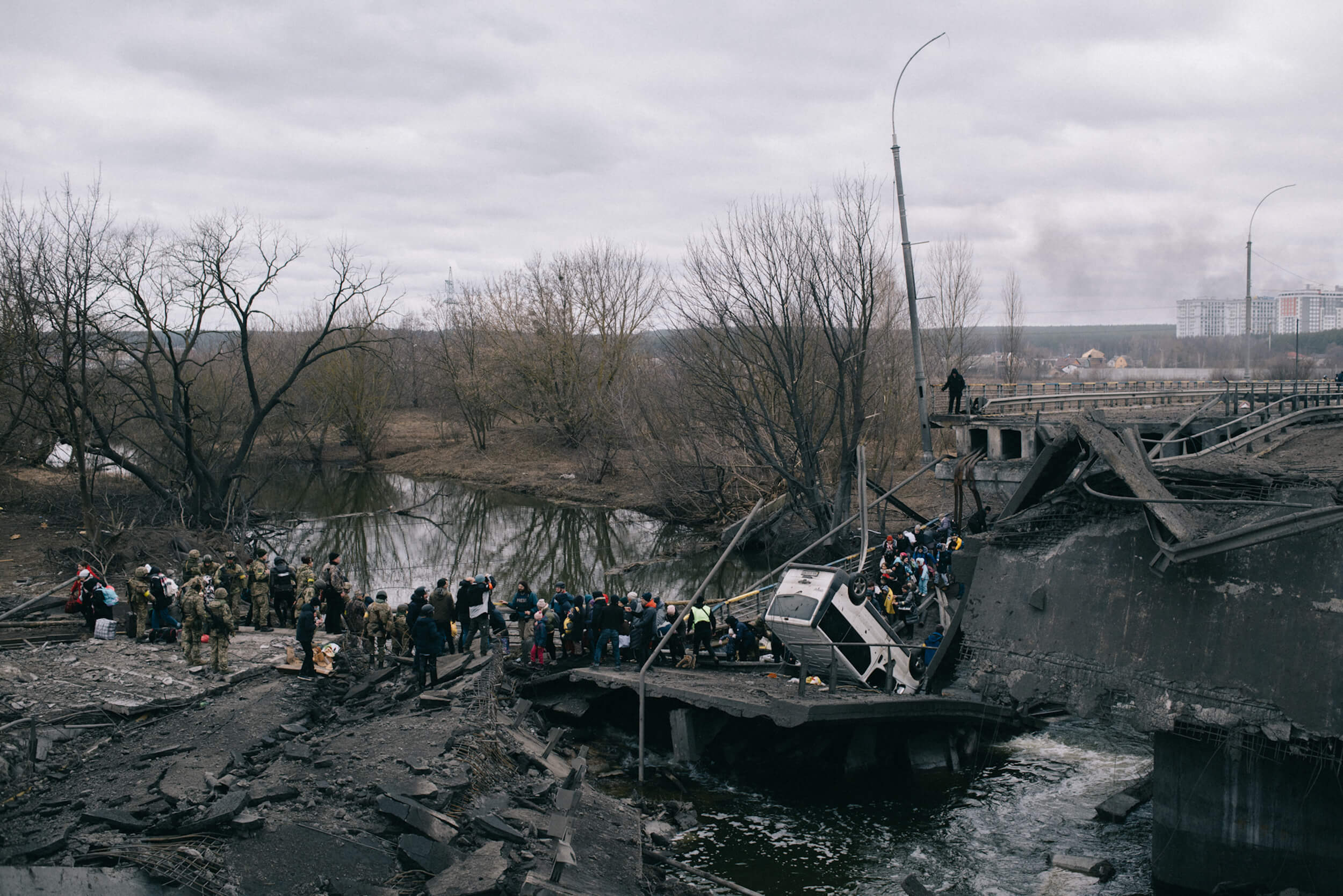
Evacuation of civilians from Irpin town, through a bridge destroyed by shelling. The bridge was destroyed by the Armed Forces of Ukraine to prevent the enemy from reaching Kyiv. On this day at 10 am women, children and the elderly were supposed to be evacuated from the town by trains, but the enemy blew up the railroad tracks, and so people were asked to move to another place, from where they should be picked up by buses for transportation to the Kyiv railway station. Irpin town, Kyiv region, Ukraine, 05 March, 2022

The bombed Russian military base in Balakleya.
Do you think we can trust Russian photographers or photographers with Russian accreditation? Do you believe that a photo itself is objective, but captions and interpretations can be decisive?
There are different photos. Of course, there are staged photos. But if we are talking about real documentary photography, then it can be used by any side. My images were used by Russian propaganda, Ukrainian propaganda, and even American propaganda. For instance, in 2014 the New York Times published fake news illustrated with my portraits of the so-called “cossacks”, who seized Kramatorsk. Then they published a refutation, but who reads those? I don’t know how to control it — maybe it is not even my job. I’m just honestly documenting what I see.
My images were used by Russian propaganda, Ukrainian propaganda, and even American propaganda.
But you said that you chose which side you were on.
I always choose the side. But I guess that documentary photographers should sometimes dial down their patriotism. Sometimes we should see the situation as God sees us, the little bugs that we are. Of course, I’m a human being, my city is under occupation, my parents had to flee. It’s hard for me to remain unbiased. But as a documentary photographer, I want to see what’s on the other side of the story. And if someone invited me to the occupied territories now, I’m not sure I’d say “no”.
You would go?
I don’t know. I don’t want to answer that question now, in the middle of the war. But I can say that in 2014, photographers in the occupied territories were free to do whatever they wanted. The occupants told us, look, you can be killed anytime, we are not responsible for you, but you can do what you want — you can even jump on a tank and take pictures from there. In the Ukrainian army, things are much more complicated. I’d like to take pictures of the Ukrainian military, I’d like to show how they work, but that’s impossible.
Is it forbidden?
Yes. Sometimes I spend two weeks negotiating a two-day visit to a military hospital. At the same time, CNN or the New York Times always have a green light. We see our story through their lenses. I don’t understand why I can’t document the history of my country. We are told that “no one is allowed to go to Kherson”, but we can clearly see that someone is.
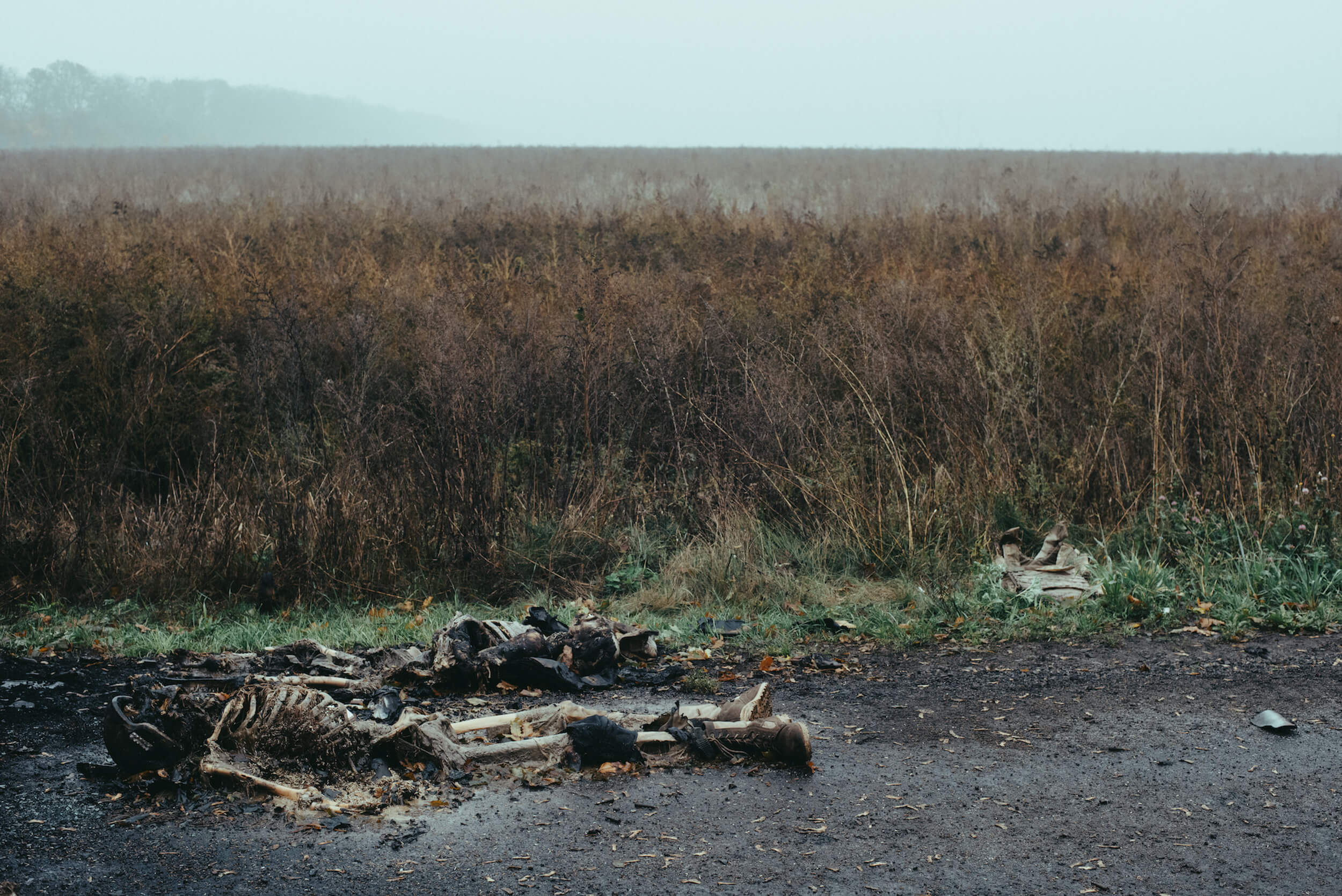
Russian soldiers were ambushed and destroyed on the Kharkiv-Izium highway. Cars and bodies were burned. 28 September 2022
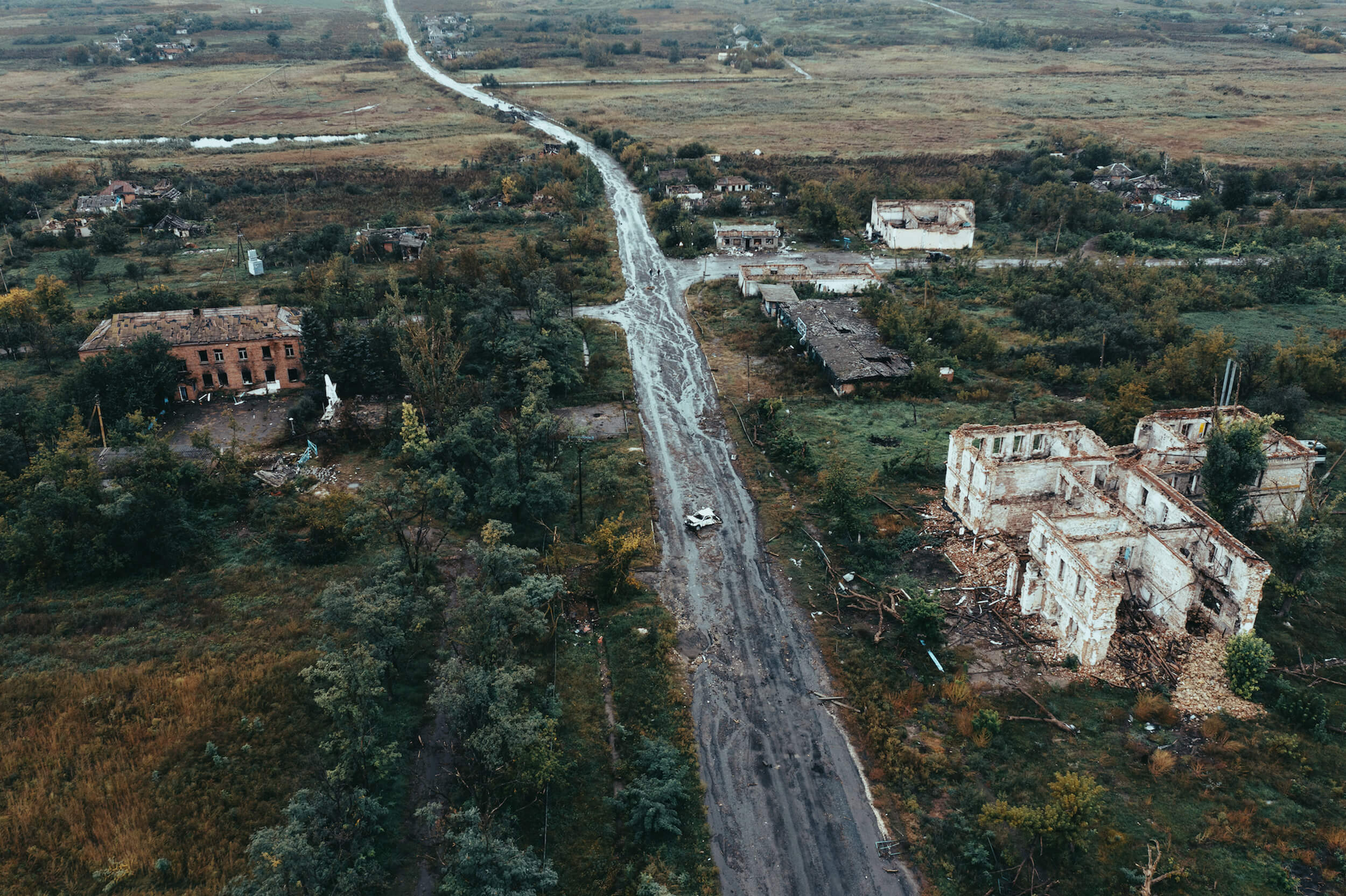
Filming from the drone, is a view of a completely destroyed village. Vlg. Velyka Komyshuvakha, Kharkiv region, 23 September 2022

Blown up Russian army tanks in a field near vlg. Barabashivka, Kharkiv region, 23 September, 2022

One of the streets of a completely destroyed village. Vlg. Kamiyanka, Kharkiv region, 30 September, 2022
Have you spotted any changes in attitude towards photographers since 2014?
Yes, it’s getting worse. I can understand why it is happening. There were a lot of journalists who got their permission and caused some trouble. Some of our soldiers say: “why do we need independent photographers if they can take pictures of things that shouldn’t be seen?”. That’s why we have press officers. Not to help photojournalists, but to control them. I get it, there are military secrets and so on. But there are also two sides of the medal.
The only way for me to work is to know people, who know someone. Or to do something like I did in Ilovaisk. I simply got into a tank and went in with the soldiers. When the artillerymen see a photographer, they say: hey, cool, come on in, we’ll just let the press service know that you are here. And then the press service comes with security and takes you ten kilometers out of there.
How about the safety of the soldiers? Don’t you think that photos of servicemen’s faces can put them in danger?
There are journalists who want to see their photos published, but I want to document history. I can postpone publishing my works until the war is over. I had taken photos of the guys in Ilovaisk who were later taken captive. I haven’t published a single photo of them during the nine months they were held in captivity. I want to document history for future generations, not for the sake of Instagram likes. But it’s hard to convey it to people.
I want to document history for future generations, not for the sake of Instagram likes.
In one of your interviews, you said that when you work with media you try to take pictures that have a shock effect and make people cry. On the other hand, that’s what propagandistic photos do, they appeal to emotions. Is there any way to tell a propagandistic photo from emotional documentation of reality?
And is there any difference, really, between propaganda and emotional documentary photography? Propaganda is just a platform that uses photography. It’s never objective — neither Russian nor Ukrainian propaganda. Check the Ukrainian Telegram channels and you will see how the Ukrainian army defeats Russian soldiers. Check the Russian Telegram channels — and you’ll see quite the opposite.
As for emotional photos, it’s a unique feature of the reporting genre. When I work on my personal art projects, I create more philosophical images. I know that people can spend a long time looking at these works at exhibitions, diving deeper into them, reflecting on them. Sometimes people accuse me of taking way too aesthetic photos. They say that one can forget that it’s a reality they are looking at, not a painting. With media, however, I only have one second to capture one’s attention, so I try to change my style. I take photos that speak for themselves. That is my way to joining the informational war and countering Russian propaganda.

Ukrainian Army positions, the 30th brigade, Eastern Ukraine.

Former Russian positions near the village of Mala Rohan, which were destroyed by Ukrainian Army on March 25. On the field there are two dead Russian soldiers, one of them tried to bear the other onto stretchers, but both fell under the shelling and died. 30 March, 2022

Exhumation of dead bodies of killed civilians by Russian occupiers, at one of the yards in the city of Bucha. Bucha city, Kyiv region, 08 April, 2022

Police and employees of the ritual service conduct identification and registration of the 58 killed civilians in the city of Bucha before sending them to morgue. Bucha city, Kyiv region, 06 April, 2022

Operating room where doctors remove fragments and bullets from the wounded soldiers of the Ukrainian army. This is the main military hospital that covers three directions - Mariupol, Donetsk and Kherson. The most severe wounded soldiers are sent here to provide first care, to stabilize their heath conditions, and after to move them through the other military hospitals. Military hospital in Zaporizhia, 20 April, 2022

The first affected child in Kyiv from bomb attacks by Russia. He fell under the shelling, in the car there were his father, mother, sister and he, a child 6 years old. Parents and sister died, the boy is in resuscitation in serious condition. Doctors because of the absence of documents, at the very beginning called him "Unknown # 1". Kyiv, Ukraine, 28 February, 2022
There were a lot of cases when Russians accused Ukrainian photographers, Yevhen Maloletka in particular, of faking images. Have your photos ever been accused of being staged?
I haven’t heard of that, maybe. The question is, what is a staged image? For instance, all portraits are staged. Even Susan Sontag wrote that a person starts acting unconsciously as soon as they see a camera. But I’m not as widely published as Yevhen Maloletka. There are so many photographers now, so I’m trying to find my own angle, my unique perception of the situation. Maybe, my photos are not popular enough to be accused of being fake. I only had this Time cover, but a lot of people don’t even know that this was my work.
Speaking of the Time cover. After it was published, Time featured Elon Musk, Zendaya, and other celebrities on its covers. Do you think photos can hold the western audience’s attention to the war?
Before the Time cover, I would say no. But I was shocked by the ability of a single publication to draw people’s attention. During the entire month, I had video calls with Japanese TV, French CNN, etc. The cover drew attention to me, and I drew attention to the war, it was like a snowball. If you can influence at least one person, who can make a difference, then you are doing the right thing. Even if this photo accelerates weapon supplies, it will be your contribution to ending the war.
Publications in well-known media make sense. At first, people want the news: they read newspapers, scroll through their Instagram feed, etc. But then the news starts fading out. People need a new Bucha, they need something bigger than Bucha, they want more blood. They open the New York Times and see the same photos of the dead, of funerals, or artillery, and all over again. People get tired. And that’s when culture comes in. I’m talking about museums, galleries, art films, and every other cultural form that asks deeper questions and offers reflections that remain relevant for a long time. We have a tremendous culture, not just vyshavankas and flower wreaths. And we need to show it, we need to nurture our photography and various cultural forms, instead of focusing only on PinchukArtCentre and cinematography.
Documenting the war is art and aesthetics or informing and bearing witness?
Depends on the author. There are painters who work in the genre of realism and try to paint a realistic apple; and then there are Impressionists who try to convey emotions. For me, it’s art. I think that photography is a language opposite to literature. If you can tell me what’s in my photos it means that I did something wrong. That’s why I don’t like magazine covers.
To me, emotional images are more important than informative ones. I would like to immerse the viewer into a visual labyrinth and make them think about what happened there and never find the answers. I’m an aesthete, I will never get the World Press Photo award. They praise the truth. But what truth are we even talking about? Documentary photography is a sculpture, not a painting. I take reality and I cut off things that I don’t need. What remains is my own vision. But if you saw what’s left behind, your viewpoint would probably change. I’m very skeptical about photographers who say that they document the truth. We manipulate people, each of us in our own way.
I’m an aesthete, I will never get the World Press Photo award.
There are different ways to document the war. You can do it like they did in Afghanistan — take a white sheet, throw in shampoos and other things that carry explosives, and take a picture. And that would be enough to show the war. You can take a photo of a soldier’s injured body or you can show blood-stained stretchers. But you don’t really need to have photography skills to show the action on a battlefield, you just need to grow some balls. Simply don’t be afraid to press the button and that’s it. But this is not quite an approach that I’m interested in.

Evacuation of civilians from Irpin town, through a bridge destroyed by shelling. The bridge was destroyed by the Armed Forces of Ukraine to prevent the enemy from reaching Kyiv. On this day at 10 am women, children and the elderly were supposed to be evacuated from the town by trains, but the enemy blew up the railroad tracks, and so people were asked to move to another place, from where they should be picked up by buses for transportation to the Kyiv railway station. Irpin town, Kyiv region, Ukraine, 05 March, 2022

The fighters of the Ukrainian army, 30th brigade, early morning in the trenches on their positions. Eastern Ukraine.

Destroyed building of the Kharkiv Regional State Administration which was destroyed by air bomb. Kharkiv, 16 March, 2022
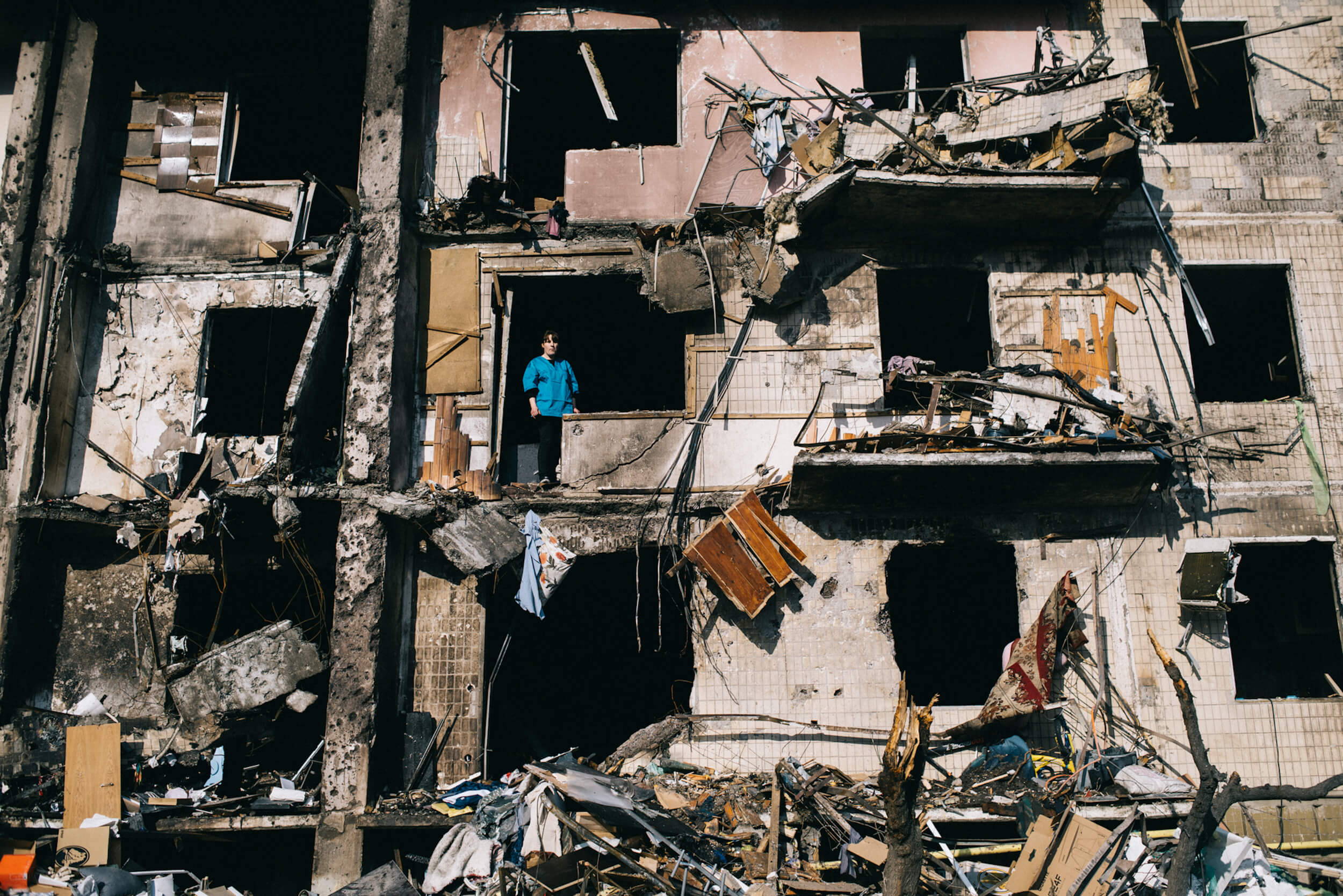
Apartment building destroyed after the rocket attack by Russia, Pozniaky district, Kyiv, Ukraine.
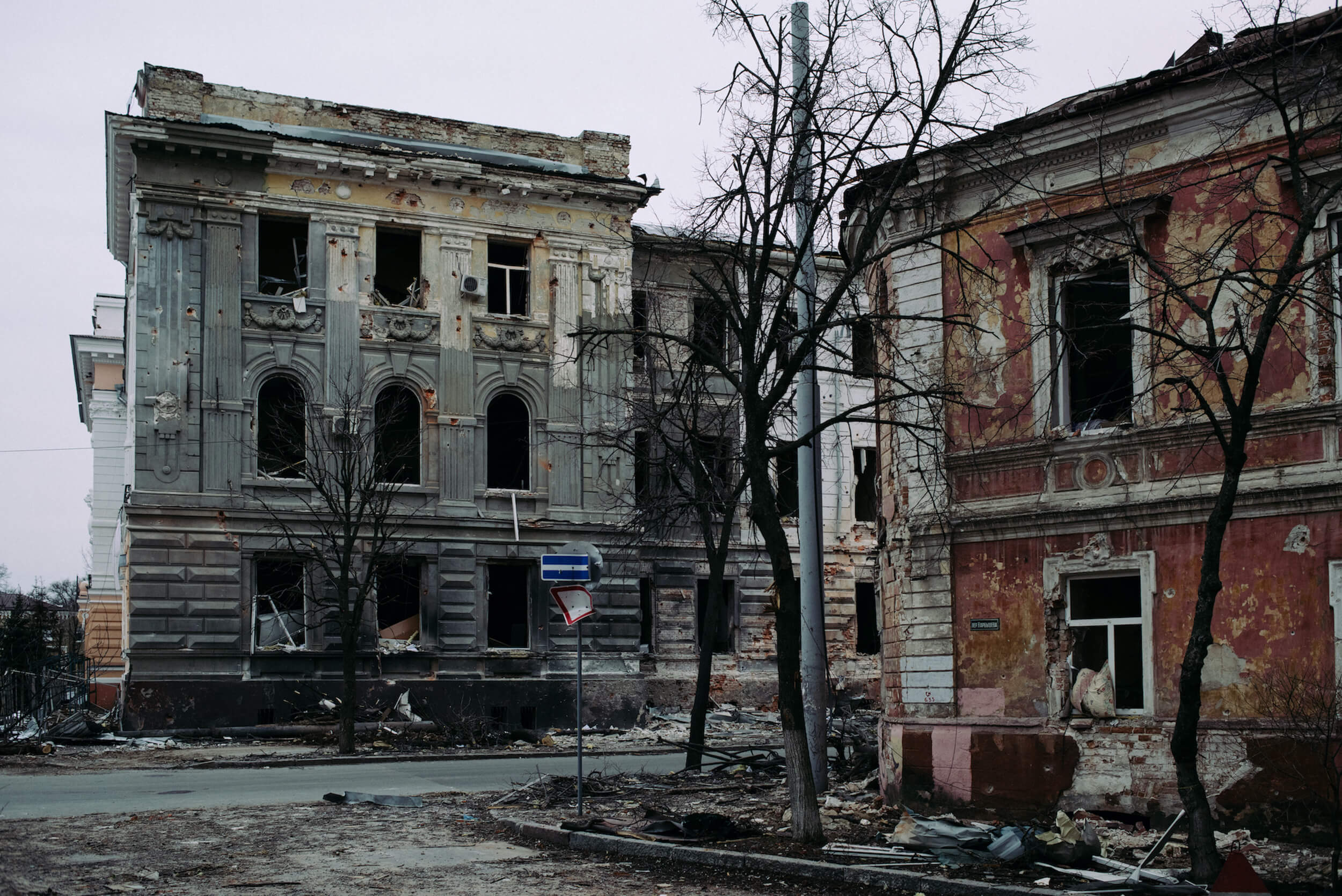
One of the streets of Kharkiv, which was destroyed as a result of several aviation strikes. Kharkiv, 26 March, 2022.

You’ve lost your colleagues in this war. How do you deal with the constant presence of death?
Death has been around since I worked on my first project about people with TB. My friends make fun of me, saying that I feel more alive when I’m at war or in a crisis. I’m not an adrenaline junkie but all my projects have something tragic about them. When there was a pause in active military operations, I worked in Chornobyl.
I’m not an adrenaline junkie but all my projects have something tragic about them.
I’m not sure if I’m still going to be a classic documentary photographer in five years. But we are at war now, and I can’t even think about creative or conceptual art. Someone has to take a weapon, and someone has to take a camera and document everything non-stop. We’ll figure out what to do with the archives later.
Do you have any objectives as a photographer? What would you like to achieve?
I’m a human being in the first place. And photography is just a form of art. I don’t have an objective, I have a meaning in life, my beacon light if I can call it so. I’ll never reach it, but it helps me to choose the direction. Objectives have no sense. One just needs to work, to do something, and sometimes life gives you all the answers. My goal is to keep taking photos my whole life, whether someone likes them or not, whether they bring me money or not. Sometimes I lose heart because of all the barriers, bans, and lack of development in real documentary photography. But despite everything, I go to the Kherson region, to Donbas, to document our history. As long as the war goes on, I’ll keep doing it.
New and best
